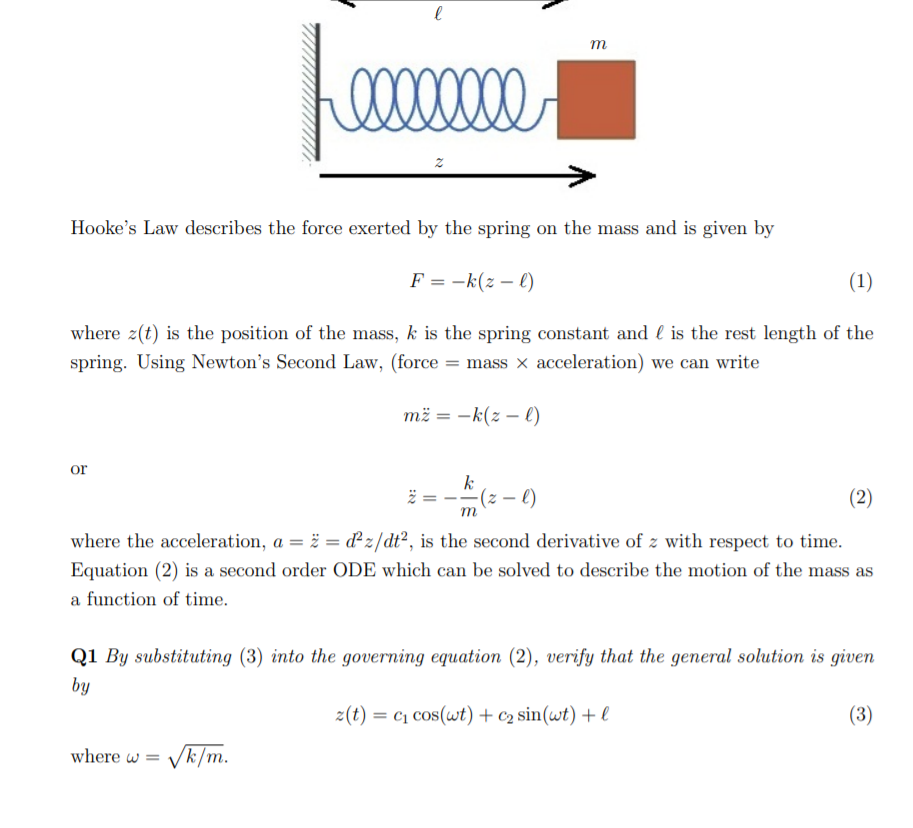B The net force is zero at the equilibrium position but the ruler has momentum and continues to move to the right. Gathering terms and dividing through by m gives you the following ODE for the spring-mass system.
Biomeca Understanding Elastic Properties Of The Skin
Force equals mass times acceleration F m x a.
. Misconception an incorrect conception Types. This is difficult to measure directly because of the smallness of the force. This essentially says that the more you stretch a spring the greater the force.
The maximum displacement from equilibrium is known as the amplitude X. Each successive layer from the top down exerts a force on the one below it. C The restoring force is in.
From Newtons second law of motion force applied to a mass causes the. Newtons second law says. Kx is Hookes law for the force exerted by a spring.
Hookes Law describes linear material behavior. Moving from a state of rest ie to accelerateForce can also be described intuitively as a push or a pull. The first law describes what happens when no force acts on an object.
The mg force is gravity. Hookes law spring constant. The net downward force on a sphere is the difference between the settling force and the buoyant force.
This reduces the period and increases the frequency. Conception construct Antonyms. Recall Hookes law first stated formally by Robert Hooke in The True Theory of Elasticity or Springiness 1676 ut tensio sic vis.
The proportionality constant is a positive value denoted by k 0 so F s -kL ut where ut is the position of mass from equilibrium when the system is set in motion. 1 n an abstract or general idea inferred or derived from specific instances Synonyms. So it can be applied to rubber as long as the strains are small.
For example if a person wanted to move a 10 kg object at an acceleration of 10 mss they would need to use a force equal to 100 Newtons. To measure the unknown force the spring constant of the torsion fiber must first be known. It is sometimes called Poiseuilles law for laminar flow or simply Poiseuilles law.
It is in fact the 1st order linearization of any hyperelastic material Law including nonlinear ones. In physics a force is an influence that can change the motion of an objectA force can cause an object with mass to change its velocity eg. Very different responses The acceleration of an object is directly proportional to the resultant.
It is commonly used for isotropic materials same behavior in all directions but can also be extended to anisotropic materials. An object attached to a spring sliding. Figure 538 a The plastic ruler has been released and the restoring force is returning the ruler to its equilibrium position.
Or translated formally into Extension is directly proportional to force. It is defined as the ratio between pressure increase and the resulting decrease in a materials volume. In contrast increasing the force constant k will increase the restoring force according to Hookes Law in turn causing the acceleration at each displacement point to also increase.
How is Hookes Law measured. Measuring the resonant vibration period of. Together with Youngs modulus the shear modulus and Hookes law the bulk modulus describes a materials response to stress or strain.
Hookes law ensures that the angle of the pointer is proportional to the current. Cavendish accomplished this by a method widely used since. Conceptualisation conceptuality conceptualization an elaborated concept notion a general inclusive concept category a general.
Push a freight train. A spherical particle placed in a Newtonian fluid will sink if the buoyant force does not match or exceed the gravitational force on the sphere. Push a shopping cart.
Plaque Deposits Reduce Blood Flow. A force has both magnitude and direction making it a vector quantity. Motion of a mass on an ideal spring.
Suppose the flow rate of blood in a coronary artery has been reduced to half its normal value. Hookes law describes the force of. Xt k m xt g 0 Note that this ODE model does not include the.
This equation describes laminar flow through a tube. Since u is. We can easily understand Hookes Law in connection with the spring constant.
Hookes law of springs says for small displacements that force F s is proportional to the length of the stretch in the spring. Which can be translated literally into As extension so force. The second law describes the response of the object to a force being applied we know that different objects respond differently to the same magnitude of force.
Nm or kgs 2. It is measured in the SI unit of newton N. Moreover this law states.
By acting like springs of course he means Hookes law. Therefore Hookes law describes and applies to the simplest case of oscillation known as simple harmonic motion. The bulk modulus is a constant the describes how resistant a substance is to compression.
Now known as Coulombs law. Stokes law describes the settling of spheres in a Newtonian fluid. The signs of mg and kx are opposite because gravity pulls in the direction of positive x and the spring pulls in the direction of negative x.
Simply put his law describes the relationship between the mass of an object the acceleration of an object and the force needed to move it. Here F represents the equal and oppositely applied to restore causing the elastic materials to get back to their original dimensions. This force always acts to restore the spring to its natural equilibrium position.
And it is the standard for metals in the.

Calculus Based Physics 2 Concept Equations Ecosia Physics Formulas Learn Physics Physics
Biomeca Understanding Elastic Properties Of The Skin

Solved M Hc Eeelll Hooke S Law Describes The Force Exerted Chegg Com

Hooke S Law Describes The Linear Relationship Between The Force F Or Download Scientific Diagram
0 Comments